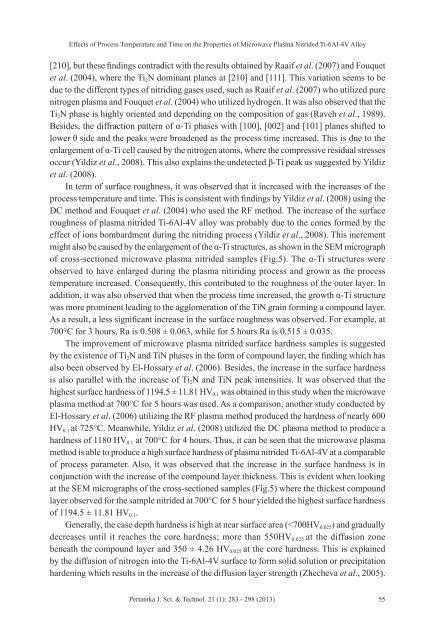JST Vol. 21 (1) Jan. 2013 - Pertanika Journal - Universiti Putra ...
JST Vol. 21 (1) Jan. 2013 - Pertanika Journal - Universiti Putra ...
JST Vol. 21 (1) Jan. 2013 - Pertanika Journal - Universiti Putra ...
You also want an ePaper? Increase the reach of your titles
YUMPU automatically turns print PDFs into web optimized ePapers that Google loves.
Effects of Process Temperature and Time on the Properties of Microwave Plasma Nitrided Ti-6Al-4V Alloy<br />
[<strong>21</strong>0], but these findings contradict with the results obtained by Raaif et al. (2007) and Fouquet<br />
et al. (2004), where the Ti 2N dominant planes at [<strong>21</strong>0] and [111]. This variation seems to be<br />
due to the different types of nitriding gases used, such as Raaif et al. (2007) who utilized pure<br />
nitrogen plasma and Fouquet et al. (2004) who utilized hydrogen. It was also observed that the<br />
Ti 2N phase is highly oriented and depending on the composition of gas (Raveh et al., 1989).<br />
Besides, the diffraction pattern of α-Ti phases with [100], [002] and [101] planes shifted to<br />
lower θ side and the peaks were broadened as the process time increased. This is due to the<br />
enlargement of α-Ti cell caused by the nitrogen atoms, where the compressive residual stresses<br />
occur (Yildiz et al., 2008). This also explains the undetected β-Ti peak as suggested by Yildiz<br />
et al. (2008).<br />
In term of surface roughness, it was observed that it increased with the increases of the<br />
process temperature and time. This is consistent with findings by Yildiz et al. (2008) using the<br />
DC method and Fouquet et al. (2004) who used the RF method. The increase of the surface<br />
roughness of plasma nitrided Ti-6Al-4V alloy was probably due to the cones formed by the<br />
effect of ions bombardment during the nitriding process (Yildiz et al., 2008). This increment<br />
might also be caused by the enlargement of the α-Ti structures, as shown in the SEM micrograph<br />
of cross-sectioned microwave plasma nitrided samples (Fig.5). The α-Ti structures were<br />
observed to have enlarged during the plasma nitiriding process and grown as the process<br />
temperature increased. Consequently, this contributed to the roughness of the outer layer. In<br />
addition, it was also observed that when the process time increased, the growth α-Ti structure<br />
was more prominent leading to the agglomeration of the TiN grain forming a compound layer.<br />
As a result, a less significant increase in the surface roughness was observed. For example, at<br />
700°C for 3 hours, Ra is 0.508 ± 0.063, while for 5 hours Ra is 0.515 ± 0.035.<br />
The improvement of microwave plasma nitrided surface hardness samples is suggested<br />
by the existence of Ti 2N and TiN phases in the form of compound layer, the finding which has<br />
also been observed by El-Hossary et al. (2006). Besides, the increase in the surface hardness<br />
is also parallel with the increase of Ti 2N and TiN peak intensities. It was observed that the<br />
highest surface hardness of 1194.5 ± 11.81 HV 0.1 was obtained in this study when the microwave<br />
plasma method at 700°C for 5 hours was used. As a comparison, another study conducted by<br />
El-Hossary et al. (2006) utilizing the RF plasma method produced the hardness of nearly 600<br />
HV 0.1 at 725°C. Meanwhile, Yildiz et al. (2008) utilized the DC plasma method to produce a<br />
hardness of 1180 HV 0.1 at 700°C for 4 hours. Thus, it can be seen that the microwave plasma<br />
method is able to produce a high surface hardness of plasma nitrided Ti-6Al-4V at a comparable<br />
of process parameter. Also, it was observed that the increase in the surface hardness is in<br />
conjunction with the increase of the compound layer thickness. This is evident when looking<br />
at the SEM micrographs of the cross-sectioned samples (Fig.5) where the thickest compound<br />
layer observed for the sample nitrided at 700°C for 5 hour yielded the highest surface hardness<br />
of 1194.5 ± 11.81 HV 0.1.<br />
Generally, the case depth hardness is high at near surface area (





